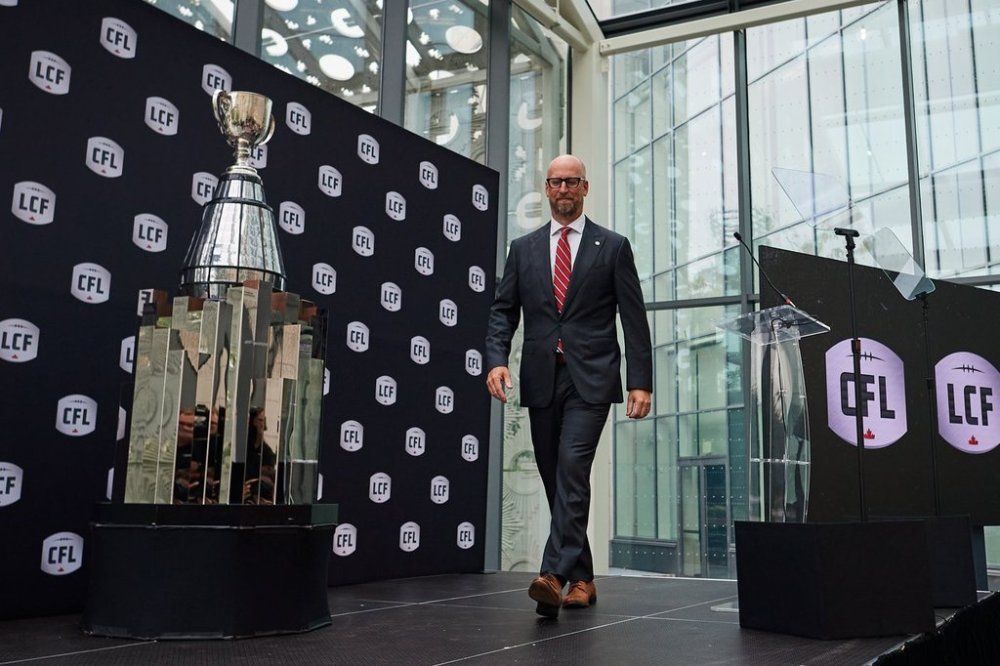Overall CFL transparency would have helped temper angst
Canadian players, coaches less agreeable with announcement of league changes
Advertisement
Read this article for free:
or
Already have an account? Log in here »
To continue reading, please subscribe:
Monthly Digital Subscription
$1 per week for 24 weeks*
- Enjoy unlimited reading on winnipegfreepress.com
- Read the E-Edition, our digital replica newspaper
- Access News Break, our award-winning app
- Play interactive puzzles
*Billed as $4.00 plus GST every four weeks. After 24 weeks, price increases to the regular rate of $19.00 plus GST every four weeks. Offer available to new and qualified returning subscribers only. Cancel any time.
Monthly Digital Subscription
$4.75/week*
- Enjoy unlimited reading on winnipegfreepress.com
- Read the E-Edition, our digital replica newspaper
- Access News Break, our award-winning app
- Play interactive puzzles
*Billed as $19 plus GST every four weeks. Cancel any time.
To continue reading, please subscribe:
Add Winnipeg Free Press access to your Brandon Sun subscription for only
$1 for the first 4 weeks*
*$1 will be added to your next bill. After your 4 weeks access is complete your rate will increase by $0.00 a X percent off the regular rate.
Read unlimited articles for free today:
or
Already have an account? Log in here »
The Canadian Football League created significant waves this week with a series of rule changes that will take place over the next two seasons, sparking heated debate among fans and media alike.
For some, it’s a step toward modernizing the game and a common-sense approach to clear and obvious issues. But for traditionalists, it’s being viewed as an unwelcome departure from what makes Canadian football unique.
Since the announcement, I’ve been asked where I stand, and like many of you who are still digesting the news, my feelings have been mixed. After a few days, I see more good than bad.
Simply put, I’m on board with the changes coming in 2026.
CFL Commissioner Stewart Johnston leaves the stage after speaking at the press conference in Toronto on Monday.
The new instant 35-second play clock replaces the old 20-second clock, which was misleading by name, as the time needed to spot the ball often led to plays lasting beyond 40 seconds. This new system should lead to more action and a better overall pace of play.
I’m also fine with the modified rouge, which will no longer reward a point for a missed field goal or any ball that travels or bounces out the sides or back of the end zone untouched. Count me among those who thought it felt weird to celebrate a missed kick, like when last season Toronto Argonauts kicker Lirim Hajrullahu sailed a field goal attempt wide but still secured the victory.
As for having the team benches on opposite sides, that’s a no-brainer and, quite frankly, long overdue.
It’s the changes coming in 2027 that I’m less enthusiastic about.
The league is cutting the field from 110 yards to 100 yards, with the end zones being shortened from 20 yards to 15. That’s a total reduction of 20 yards — a significant structural change that will make the field look and feel noticeably different.
Then there’s the decision to move the goalposts from the front of the end zone to the back. This effectively eliminates the long returns on missed field goals, which are among the CFL’s most exciting plays, such as the 128-yard touchdown by Winnipeg Blue Bombers rookie Trey Vaval just this past Saturday in a win over Ottawa.
By commissioner Stewart Johnston’s own admission, this is a change he’s wanted since his amateur football days. You almost got the impression that had he just been able to thread the needle on a 35-yard pass to his young teammate all those years ago — a story he dove into when asked about the goalposts — we might not even be here today.
These changes are clearly designed to appeal to a broader audience, particularly in the United States, where a new TV deal is needed after 2026. The shift feels like a move to make the game look more American, while still trying to sell it as being uniquely Canadian.
While the league will spend the next two years trying to build up the Canadiana of the game while looking more like its neighbours to the south, there’s a real fear among fans that the line is being moved. And once it starts, there’s no telling where it will stop.
The real issue I see here is a fear of the unknown. Unfortunately, it’s a feeling that fans of the three-down game are all too familiar with.
Now, here are some more thoughts and insights I’ve collected since the announcement, in the latest edition of CFL Rundown.
1) Perhaps the most surprising element of this week’s news, beyond the changes themselves, was the secrecy surrounding them.
For a league notorious for loose lips, the CFL kept this under wraps for months, with no media leaks ahead of Monday’s press conference.
Commissioner Johnston seemed to take great pride in this fact, which I was told included the signing of NDAs for those in the know.
I was also told the professionalism on display at the press conference — from the high-end venue to the polished video content — signals a new level of seriousness by the league’s board of governors.
2) There has been a lot of discussion about the CFL’s lack of consultation on the rule changes.
The league’s board relied on internal knowledge, rather than collaborating with general managers, coaches or players.
This was a deliberate choice.
Any formal consultation would have been derailed by strong opposition and couldn’t have been trusted to stay secret.
This wasn’t a collaboration; it was a unilateral decision to push through the board’s vision. The clear message to the teams was to get on board with the new CFL.
3) Player reaction was swift, with B.C. Lions quarterback Nathan Rourke calling the new rules “garbage.”
Blue Bombers head coach Mike O’Shea also voiced his displeasure, arguing the changes remove what is “uniquely ours.”
MIKE DEAL / FREE PRESS Winnipeg Blue Bombers head coach Mike O’Shea (second left) has voiced his displeasure over the CFL announcement. The North Bay, Ont. product argues the changes remove what is “uniquely ours.”
On the other hand, quarterbacks Zach Collaros, Bo Levi Mitchell and Davis Alexander seem fine with the changes, agreeing it modernizes the game.
One key divide is clear: the most vocal against the changes are Canadian, while many of the American players appear to be good with the league’s direction.
I’m not suggesting this will be an issue, but it could create a divide in the locker room, the same way that juiced salaries for Canadians have caused friction.
4) My email inbox was filled with messages from fans. While a vocal majority is adamantly against the new changes — with some threatening to give up their season tickets — there’s another group taking a more diplomatic wait-and-see approach.
It’s difficult to gauge the true feelings across the entire country from this prairie hotbed of traditionalists, but it’s clear the loudest protests are originating from Manitoba and Saskatchewan, the only two organizations believed to turn an annual profit.
5) Let’s talk about the claim that seven of nine teams lose money every year.
While not unbelievable, we’re only shown the financial books for Winnipeg and Saskatchewan, both of which are making money.
Until the league provides a full, transparent look at its finances, this unproven narrative feels like the biggest lie in the CFL.
Without full disclosure, why should any of us just take the league’s word for it?
6) Why now? Announcing such fundamental changes mid-season seems like a risky move.
The easy answer is logistical — teams and stadiums need enough time to plan for the 2027 structural changes, which could include renovations for some venues.
But the timing is politically precarious.
While the league calls the changes “modernization,” critics are calling it “Americanization.”
Johnston surely knew that shortening the field and moving the goalposts would create this narrative.
With anti-American sentiment already high, it’s a serious risk to appear to be looking more like our friends south of the border.
It’s also a risky move given fans now have time to cancel their 2026 season tickets.
7) There has been angst over the lack of consultation with collegiate and high school football.
I don’t believe it was imperative for the CFL to inform these leagues, for the same reason they didn’t tell their own teams — to maintain secrecy.
Amateur programs will have the choice to adopt the changes or not.
The field size won’t matter much for development, but it will create a financial hurdle.
There’s been no word on who will cover these costs for amateur clubs, but the CFL should certainly offer support.
8) I see a lot of confusion over the new 35-second clock, especially in the final three minutes.
Here’s how it will work: the play clock will begin automatically on an in-bounds play, but the game clock won’t start until the ball is spotted.
While it won’t be a full 35-second run off, it will likely drain more than 20 seconds.
This is my favourite new rule, and my guess is it will lead to more plays per game, not less, even if the ending comes a bit quicker.
9) The commissioner proudly proclaimed the league was “trading field goals for touchdowns,” predicting an additional 60 touchdowns per season.
The main rationale is that the new layout of the field encourages third-down gambles.
For example, a manageable 42-yard field goal from the opponent’s 35-yard line becomes a much harder 57-yard kick under the new rules.
The league believes this will lead to more third-down conversions and fewer punts.
However, more gambles also mean more turnovers, which could ultimately lead to less scoring overall.
It will be interesting to see what the result is and something I’ll be following very closely.
jeff.hamilton@freepress.mb.ca

Jeff Hamilton
Multimedia producer
Jeff Hamilton is a sports and investigative reporter. Jeff joined the Free Press newsroom in April 2015, and has been covering the local sports scene since graduating from Carleton University’s journalism program in 2012. Read more about Jeff.
Every piece of reporting Jeff produces is reviewed by an editing team before it is posted online or published in print — part of the Free Press‘s tradition, since 1872, of producing reliable independent journalism. Read more about Free Press’s history and mandate, and learn how our newsroom operates.
Our newsroom depends on a growing audience of readers to power our journalism. If you are not a paid reader, please consider becoming a subscriber.
Our newsroom depends on its audience of readers to power our journalism. Thank you for your support.
History
Updated on Wednesday, September 24, 2025 8:47 PM CDT: Fixes headline















